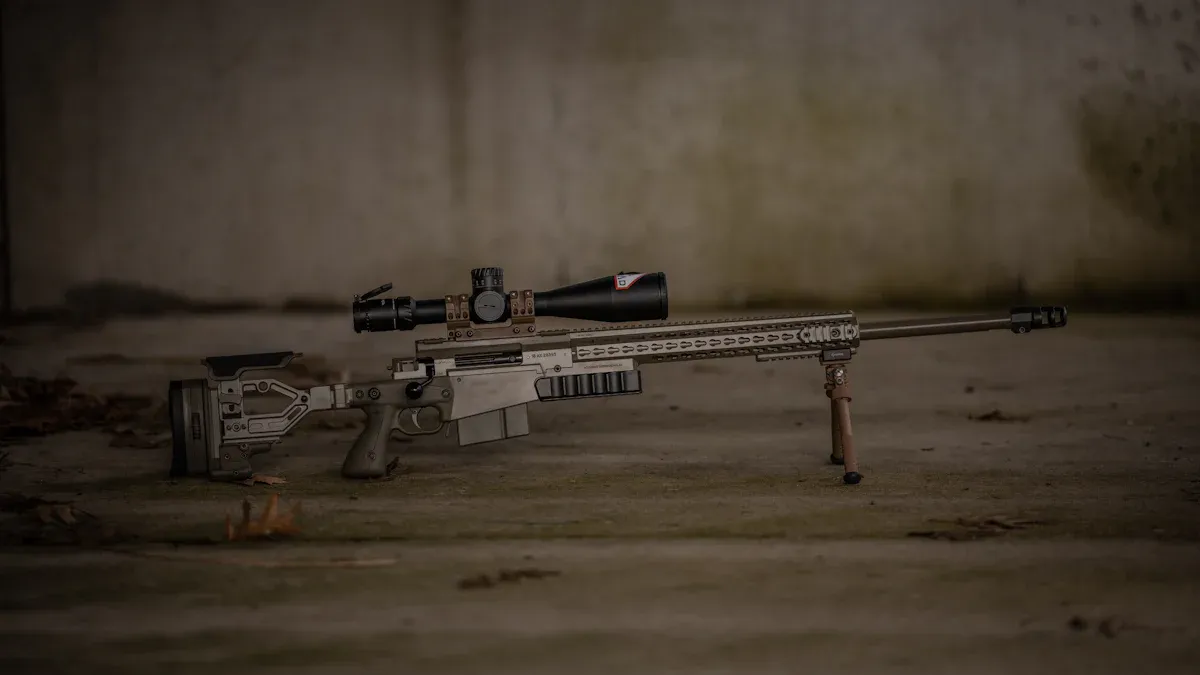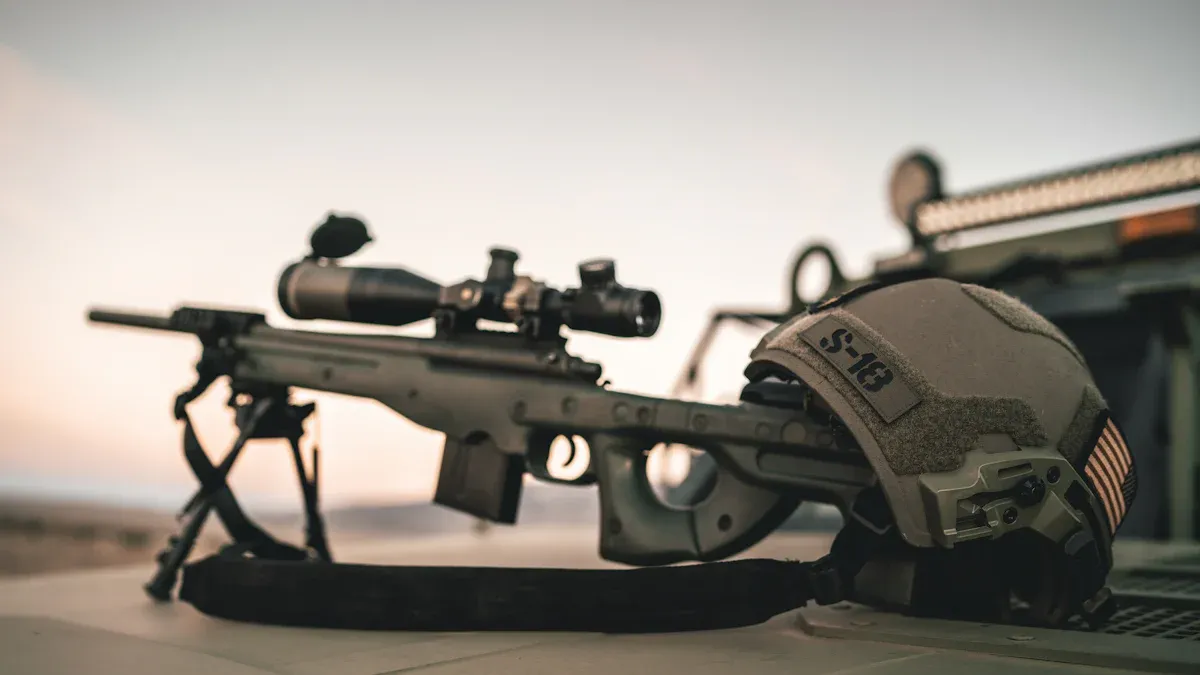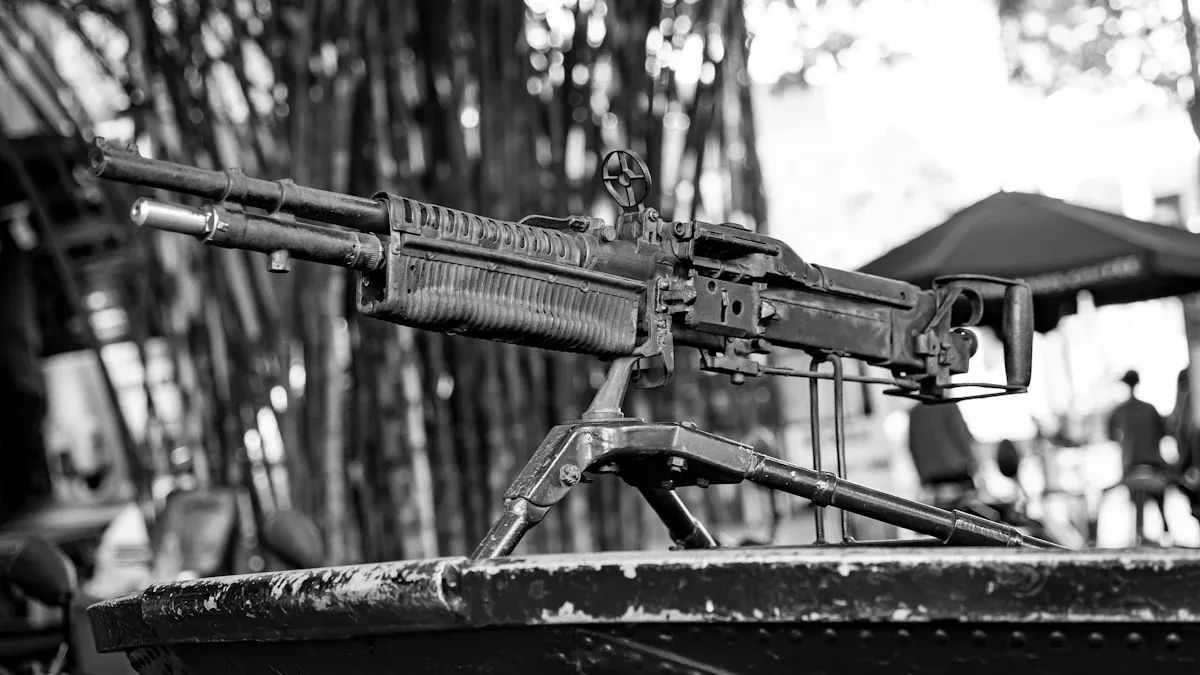
Adjustable rifle bipods provide unmatched stability, crucial for precision shooting. By minimizing movement caused by fatigue or environmental factors, they allow shooters to maintain consistent aim. When paired with a rifle scope and mounted on a rail, these accessories enhance accuracy, making them indispensable for long-range shooting in diverse conditions.
Key Takeaways
- Adjustable bipods make shooting steadier, helping with accurate shots. This steadiness lets shooters stay focused and aim better at targets.
- Pick a bipod with adjustable height and strong locks. These features make it useful on different grounds and in various positions.
- Think about how and where you shoot before buying a bipod. Knowing what you need helps you pick one that improves your shooting.
Why an Adjustable Bipod is Essential for Long-Range Shooting

Enhances Stability for Precision Shots
Stability is a cornerstone of precision shooting, and adjustable bipods excel in providing it. Features like rubber feet ensure a firm grip on surfaces ranging from dirt to concrete, reducing unwanted movement. The inclusion of a swivel mechanism allows shooters to rotate their rifles without repositioning the bipod, maintaining accuracy during dynamic scenarios. Additionally, versatile leg adjustments accommodate different shooting positions, ensuring a solid base for consistent aim. Field tests have demonstrated that even with minor play in the pivot pin, bipods maintain reliable performance, especially when equipped with a cinch lever to eliminate instability.
Adapts to Different Terrains and Shooting Positions
Adjustable bipods are designed to adapt to diverse environments and shooting stances. Hunters and marksmen benefit from features like 45-degree tilt capabilities, which allow adjustments to uneven terrain. Rubber feet provide stability on surfaces such as grass, rocks, and concrete, ensuring reliable support in challenging conditions. The ability to rotate and splay legs enhances height and position flexibility, making transitions between prone, sitting, and standing positions seamless. This adaptability proves invaluable in dynamic shooting scenarios, where conditions can change rapidly.
Reduces Shooter Fatigue During Extended Sessions
Extended shooting sessions often lead to muscle fatigue, impacting accuracy. Adjustable bipods alleviate this strain by providing a stable platform for the rifle, reducing the effort required to maintain aim. By minimizing physical stress, shooters can focus on their targets for longer periods without compromising comfort. This feature is particularly beneficial for hunters and competitive shooters who spend hours in the field or at the range.
Improves Accuracy in Challenging Conditions
Environmental factors like wind and uneven terrain can challenge shooting accuracy. Adjustable bipods counter these obstacles by offering enhanced stability and consistent positioning. By minimizing movement caused by fatigue or external conditions, they allow shooters to concentrate on their aim. Features like adjustable legs and swivel mechanisms ensure precision even in less-than-ideal circumstances, making them indispensable for long-range shooting.
Key Features to Look For
Adjustability
Adjustability is a critical feature in any rifle bipod. Shooters require the ability to modify the height and angle of the bipod to match different terrains and shooting positions. Top-rated models, such as the Harris HBRMS and MDT Ckye-Pod Gen2, offer adjustable ranges from 6 to 18 inches, ensuring versatility in various scenarios. A bipod with a swivel mechanism or canting capability further enhances adaptability, allowing users to maintain stability on uneven ground. These features make it easier to achieve precision, even in challenging conditions.
Stability and Locking Mechanisms
Stability is essential for accurate shooting, and locking mechanisms play a significant role in maintaining it. Screw locks provide superior security, while lever locks allow for quicker adjustments. Many bipods, like those from Atlas, include a swivel feature with up to 30 degrees of cant or pan, ensuring the legs remain stable during use. Additionally, the ability to configure the open position angle enhances the shooter’s control, making these mechanisms indispensable for long-range accuracy.
Material Quality and Durability
The material of a bipod determines its durability and weight. Aluminum offers an excellent strength-to-weight ratio, while steel provides added stability for larger calibers. Carbon fiber is ideal for those prioritizing lightweight options without compromising sturdiness. Shooters often prefer brands like Harris and Atlas for their proven reliability in competitive and field settings, showcasing the importance of high-quality materials.
Weight and Portability
Weight and portability are crucial for shooters who need to carry their equipment over long distances. Lightweight options, such as the MDT Ckye-Pod Lightweight and Magpul bipods, weigh as little as 8 ounces, making them ideal for hunters and backcountry shooters. These models balance reduced weight with robust construction, ensuring they remain functional without adding unnecessary bulk.
Compatibility with Rifles and Mounting Systems
A bipod must be compatible with the rifle and its mounting system to function effectively. Popular attachment systems include Picatinny and M-Lok rails, which are widely supported by brands like Magpul and Caldwell. Shooters should ensure their chosen bipod aligns with their rifle’s specifications to avoid compatibility issues. User reviews and brand reputation can provide valuable insights into real-world performance and ease of installation.
Popular Adjustable Bipods and Their Features

Harris S-Series Bipod: Known for its versatile leg adjustments (9 to 13 inches) and durability.
The Harris S-Series Bipod stands out for its quick deployment and robust construction. Its legs adjust between 9 and 13 inches, making it suitable for various shooting positions. Built with an aluminum alloy frame and steel reinforcements, it balances durability with a lightweight design. Military units have tested this bipod in harsh environments, proving its reliability.
| Feature | Description |
|---|---|
| Quick Deployment | Deploys in under 2 seconds, enabling rapid setup in high-stress situations. |
| Robust Construction | Combines aluminum alloy with steel for critical parts, ensuring longevity. |
| Proven Reliability | Trusted by military personnel in extreme conditions. |
Atlas BT46-LW17 PSR Bipod: Ideal for precision shooting with its 15-degree pan and cant capabilities.
The Atlas BT46-LW17 PSR Bipod excels in precision shooting. It offers a height range of 7 to 13 inches and features 15-degree pan and cant adjustments. Its T7075 aluminum legs ensure durability under heavy recoil. Users praise its flawless performance and suitability for high-caliber rifles.
| Specification | Details |
|---|---|
| Height Range | 7.0 – 13.0 inches |
| Mounting Options | ADM 170-S Lever on Picatinny rail |
| Pan and Cant | 15 degrees +/- |
| Weight | 15.13 ounces |
Magpul Bipod: Balances lightweight design with robust construction and quick-deploy features.
The Magpul Bipod combines a lightweight design with durable materials. Constructed from Mil-Spec hard anodized 6061 T-6 aluminum and stainless steel, it weighs only 11.8 ounces. Its user-friendly leg deployment and adjustable features enhance functionality. Shooters appreciate its panning and tilting capabilities, which outperform many competitors.
- Material: Mil-Spec hard anodized aluminum and stainless steel.
- Weight: 11.8 ounces, with a variant as light as 8 ounces.
- Features: Adjustable legs, quick deployment, and panning/tilting capabilities.
MDT Ckyepod: Best for extreme adjustability, extending from 14.5 to 36 inches for diverse shooting needs.
The MDT Ckyepod offers unmatched adjustability, making it a favorite among competitive shooters. Its height ranges from 6.6 to 36.9 inches, with a massive 170° cant and 360° panning capabilities. Despite its higher price, its versatility justifies the investment.
| Feature | Specification |
|---|---|
| Height Adjustability | 6.6″ to 36.9″ |
| Canting Capability | 170° |
| Panning Capability | 360° (lockable) |
| Weight (Double-Pull) | 1 lb 10 oz |
The MDT Ckyepod is now used by 71% of top shooters, highlighting its popularity and performance in competitive settings.
How to Choose the Right Bipod for Your Needs
Assess Your Shooting Style and Environment
Understanding your shooting style and environment is crucial when selecting a bipod. Shooters who frequently adopt prone or sitting positions on solid ground benefit from high bipod suitability. However, those operating in soft terrain may find traditional bipods less effective. In such cases, alternative supports or specialized models may be necessary.
| Shooting Position | Environment | Bipod Suitability |
|---|---|---|
| Prone | Solid ground | High |
| Sitting | Solid ground | High |
| Standing | Solid ground | Moderate |
| Prone | Soft terrain | Low |
| Sitting | Soft terrain | Low |
| Standing | Soft terrain | Low |

Prioritize Features Based on Your Goals
Different shooting goals demand specific bipod features. Competitive shooters often prioritize adjustability and quick-detach mounting systems for rapid transitions. Hunters may value lightweight materials like carbon fiber for portability. For those shooting in rugged terrains, steel bipods offer added stability. User reviews and brand reputation provide valuable insights into durability and functionality, helping shooters make informed decisions.
- Consider materials: aluminum for lightness, steel for strength, or carbon fiber for a balance of both.
- Evaluate adjustability: ensure the bipod adapts to various terrains and shooting positions.
- Check mounting systems: compatibility with Picatinny or M-Lok rails is essential.
Consider Your Budget and Long-Term Use
Budget plays a significant role in choosing a bipod. While premium models like the Atlas BT46-LW17 offer advanced features, budget-friendly options like Harris-style bipods provide reliable performance for casual shooters. Investing in a durable, high-quality model ensures long-term use, reducing the need for frequent replacements. Shooters should weigh the cost against the features they require to find the best value.
Test and Compare Options Before Buying
Testing multiple bipods before purchasing helps identify the best fit for individual needs. Borrowing a bipod or testing models at a range provides hands-on experience. Online resources, such as YouTube reviews and user feedback, offer additional insights into performance and potential issues. Comparing features like leg length, adjustability, and mounting systems ensures the chosen bipod meets all requirements.
- Borrow or test bipods at a range.
- Watch product reviews for hands-on demonstrations.
- Read user feedback to uncover hidden strengths or weaknesses.
Adjustable rifle bipods enhance long-range shooting by providing stability, adaptability, and precision. Shooters consistently report improved accuracy and comfort.
| Evidence Type | Description |
|---|---|
| Performance Statistic | A competitor achieved tight groupings at over 800 yards using an adjustable bipod. |
| User Testimonial | A hunter noted quick setup in varied terrain, leading to successful long-range shots. |
| User Experience | Bipods improved comfort, making shooting more enjoyable and productive. |
Selecting a bipod with features like adjustability, durability, and compatibility ensures optimal performance tailored to individual needs.
FAQ
What is the ideal height range for an adjustable rifle bipod?
The ideal height range depends on the shooting position. For prone shooting, 6-9 inches works best. Taller bipods, up to 36 inches, suit sitting or standing positions.
How do I maintain my rifle bipod for long-term use?
Regularly clean the bipod to remove dirt and debris. Lubricate moving parts to prevent rust. Inspect locking mechanisms periodically to ensure proper functionality.
Can a single bipod work for multiple rifles?
Yes, many bipods feature universal mounting systems like Picatinny or M-Lok. Ensure compatibility with each rifle’s rail system before switching between firearms.
Tip: Always test the bipod’s fit and stability after attaching it to a new rifle to avoid performance issues.
Post time: Mar-24-2025
